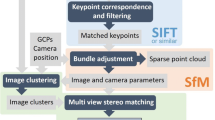Abstract
In the last 10 years, Multiple-Point Statistics (MPS) modeling has emerged in Geostatistics as a valuable alternative to traditional variogram-based and object-based modeling. In contrast to variogram-based simulation, which is limited to two-point correlation reproduction, MPS simulation extracts and reproduces multiple-point statistics moments from training images; this allows modeling geologically realistic features, such as channels that control reservoir connectivity and flow behavior. In addition, MPS simulation works on individual pixels or small groups of pixels (patterns), thus does not suffer from the same data conditioning limitations as object-based simulation. The Single Normal Equation Simulation program SNESIM was the first implementation of MPS simulation to propose, through the introduction of search trees, an efficient solution to the extraction and storage of multiple-point statistics moments from training images. SNESIM is able to simulate three-dimensional models; however, memory and speed issues can occur when applying it to multimillion cell grids. Several other implementations of MPS simulation were proposed after SNESIM, but most of them manage to reduce memory demand or simulation time only at the expense of data conditioning exactitude and/or training pattern reproduction quality. In this paper, the original SNESIM program is revisited, and solutions are presented to eliminate both memory demand and simulation time limitations. First, we demonstrate that the time needed to simulate a grid node is a direct function of the number of uninformed locations in the conditioning data search neighborhood. Thus, two improvements are proposed to maximize the ratio of informed to uniformed locations in search neighborhoods: a new multiple-grid approach introducing additional intermediary subgrids; and a new search neighborhood designing process to preferentially include previously simulated node locations. Finally, because SNESIM memory demand and simulation time increase with the size of the data template used to extract multiple-point statistics moments from the training image and build the search tree, a simple method is described to minimize data template sizes while preserving training pattern reproduction quality.










Similar content being viewed by others
References
Arpat B, Caers J (2007) Stochastic simulation with patterns. Math Geol 39:177–203
Deutsch C, Journel A (1998) GSLIB: geostatistical software library and user’s guide, 2nd edn. Oxford University Press, Oxford
Goovaerts P (1997) Geostatistics for natural resources evaluation. Oxford University Press, Oxford
Guardiano F, Srivastava M (1993) Multivariate geostatistics: beyond bivariate moments. In: Soares (ed) Geostatistics-Troia. Kluwer Academic, Dordrecht, pp 133–144
Harding A, Strebelle S, Levy M, Thorne J, Xie D, Leigh S, Preece R, Scamman R (2004) Reservoir facies modeling: new advances in MPS. In: Leuangthong O, Deutsch C (eds) Proceeding of the 2004 international geostatistics congress. Springer, Banff, pp 559–568
Honarkhah M, Caers J (2010) Stochastic simulation of patterns using distance-based pattern modeling. Math Geosci 42:487–517
Journel A (2002) Combining knowledge from diverse sources: an alternative to traditional data independence hypotheses. Math Geol 34:573–594
Liu Y, Harding A, Abriel W, Strebelle S (2004) Multiple-point statistics simulation integrating wells, seismic data and geology. Am Assoc Pet Geol Bull 88:905–921
Mariethoz G, Renard P, Straubhaar J (2010) The direct sampling method to perform multiple-point simulations. Water Resour 46:W11536
Straubhaar J, Renard P, Mariethoz G, Froidevaux R, Besson O (2011) An improved parallel multiple-point algorithm using a list approach. Math Geosci 43:305–328
Strebelle S (2000) Sequential simulation drawing structures from training images. Dissertation, Stanford University
Strebelle S (2002) Conditional simulation of complex geological structures using multiple-point geostatistics. Math Geol 34:1–22
Strebelle S, Remy N (2004) Post-processing of multiple-point geostatistical models to improve reproduction of training patterns. In: Leuangthong O, Deutsch C (eds) Proceeding of the 2004 international geostatistics congress. Springer, Banff, pp 979–988
Strebelle S, Payrazyan K, Caers J (2002) Modeling of a deepwater turbidite reservoir conditional to seismic data using multiple-point geostatistics. SPE paper 77425
Tran T (1994) Improving variogram reproduction on dense simulation grids. Comput Geosci 20:1161–1168
Wu J, Zhang T, Journel A (2008) A fast FILTERSIM simulation with score-based distance. Math Geosci 40:773–788
Zhang T, Switzer P, Journel A (2006) Filter-based classification of training image patterns for spatial simulation. Math Geol 38:63–80
Acknowledgements
The authors would like to thank Marjorie Levy for her internal review and editing of this paper.
Author information
Authors and Affiliations
Corresponding author
Rights and permissions
About this article
Cite this article
Strebelle, S., Cavelius, C. Solving Speed and Memory Issues in Multiple-Point Statistics Simulation Program SNESIM. Math Geosci 46, 171–186 (2014). https://doi.org/10.1007/s11004-013-9489-7
Received:
Accepted:
Published:
Issue Date:
DOI: https://doi.org/10.1007/s11004-013-9489-7




